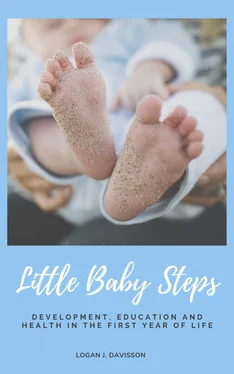Little Baby Steps:
Development, Education And Health In The First Year Of Life
(Parents Guide)
Reproduction, translation, further processing or similar actions for commercial purposes as well as resale or other publications are not permitted without the written consent of the author.
Copyright © 2019 - Logan J. Davisson
All rights reserved.
Baby upbringing and developmentin the first year of life Baby upbringing and developmentin the first year of life During the nine months of pregnancy, preparations are made for the arrival of the new roommate. The children's room will be equipped for infants with a cot, baby changing unit, music box, a mobile over the bed and many other things that you as parents will enjoy, so that the little person will feel completely at home in the new environment. Who expects the first child, does not know at all, which large changes occur. Even if you inform yourself with books, videos and with other parents, you still do not have the knowledge, which you need for your small earth citizen. Because every infant is different. They may have learned to wrap the infant and satisfy needs such as sleep and hunger. But there is much more in this little person that keeps you on your toes, doesn't let you sleep at night and completely turns your normal daily routine upside down. There is also a certain anxiety about doing something wrong or not interpreting the child's signals correctly, especially when young people move into their new home for the first time after birth. The first weeks are very turbulent. But your baby develops a little further every day and learns new things. This little miracle will amaze you when you experience the growth and development in the first months up close. Enjoy this time, because you can't bring them back, even if you sometimes reach the limit of your strength. Throw your fears and concerns overboard and look forward to the wonderful challenge that awaits you after the birth of your child. Trust your intuition in many things, which will present you with the right decision in dealing with your little human child on a silver platter. Enjoy the development that you experience every day at first hand.
Important milestones in baby development in the first year of life
Key points of early childhood development
Crawl and run - the main thing is to move forward with well thought-out safety!
Seeing the world with children's eyes
Protect against accidents with fitness and motor skills
Why babies don't want to sleep
Does your baby have fixed sleeping times and fall asleep rituals?
Do you ignore signs of fatigue?
Is your child flooded with stimuli?
Did you get carried away with the wrong conditioning?
Does your baby often sleep in your bed?
Are there disagreements between you and your partner about falling asleep?
Do you let your baby sleep everywhere?
Does your baby stay up as long as you do, so you can sleep through it?
Surrender is not an option!
Changing the bed
Learn to sleep properly and sleep well
Screaming baby - the horror of all parents
Difficulties to process environmental stimuli
Tips to calm writing babies
Baby vaccinations pros and cons
From milk to porridge - food has to be learned!
Feed supplementary food and overcome the first hurdle
What does learning to eat actually mean?
Baby equipment - what the little ones really need!
Clothing for the baby
Baby clothes vs. cool clothes
Dress sizes for baby
Equipment for babies during transport
Mastering the big challenge well from the start
Baby upbringing and developmentin the first year of life
During the nine months of pregnancy, preparations are made for the arrival of the new roommate. The children's room will be equipped for infants with a cot, baby changing unit, music box, a mobile over the bed and many other things that you as parents will enjoy, so that the little person will feel completely at home in the new environment.
Who expects the first child, does not know at all, which large changes occur. Even if you inform yourself with books, videos and with other parents, you still do not have the knowledge, which you need for your small earth citizen. Because every infant is different.
They may have learned to wrap the infant and satisfy needs such as sleep and hunger. But there is much more in this little person that keeps you on your toes, doesn't let you sleep at night and completely turns your normal daily routine upside down.
There is also a certain anxiety about doing something wrong or not interpreting the child's signals correctly, especially when young people move into their new home for the first time after birth. The first weeks are very turbulent. But your baby develops a little further every day and learns new things.
This little miracle will amaze you when you experience the growth and development in the first months up close.
Enjoy this time, because you can't bring them back, even if you sometimes reach the limit of your strength.
Throw your fears and concerns overboard and look forward to the wonderful challenge that awaits you after the birth of your child. Trust your intuition in many things, which will present you with the right decision in dealing with your little human child on a silver platter. Enjoy the development that you experience every day at first hand.
Important milestones in baby development in the first year of life
There will never again be a time in your child's life when development progresses as rapidly as in the first three months of life. After the birth your baby will lose weight first of all. You do not need to worry about this, because this decrease is quite normal. It is part of the process of adaptation to the new life that takes place outside the womb. Even if the little ones know how to suck, they still have to learn how to drink first. About ten percent of the birth weight is lost in the first few days.
If your baby is around 10 days old, it will usually regain weight and grow between two and four centimetres in the first month.
A quarter of the body weight is the head of a newborn. To hold this, however, the strong muscles are still missing. In an adult, the head accounts for only ten percent of the body weight. At the beginning, the bladder of newborns is still very small, so that it can only absorb 60 to 100 ml of urine. In the same way the feeling for the bladder is not yet developed, why the newborns so often in the diapers make.
A baby's stomach is just the size of a hen's egg. Once they are full after feeding, a feeling of hunger quickly returns.
Therefore, it is not surprising that your newborn baby is regularly fed at night in order to satisfy the apparently insatiable hunger.
Newborns cannot yet consciously grasp and move. Even if the little ones hold on to one of your fingers by gently touching the palms of their hands, this movement is based on the gripping reflex.
After the first month, the newborn transforms and becomes a baby. You will notice that the facial features change, the waking phases become longer and the legs stretch. The musculature begins to develop. First the neck muscles are strengthened, then the shoulder and back muscles and finally the muscles in the legs. Already after four weeks your baby moves his mouth to talk to you.
Meanwhile, the time has also come when the head can be turned to the side.
In the sixth week you notice that your baby has grown.
At the same time, this growth spurt also ushers in a new phase of development. The hunger is getting much bigger. You will also notice that the little ones are satisfied or complacent.
In the second month of life the development into a social being takes place. Your baby smiles a lot and likes to and is therefore irresistible. The eyes become more alert and attentive. Eye contact is sought and the direct surroundings are observed with interested glances. The small humans grow up to 2,5 cm in the month and the head-circumference becomes bigger around 1,2 cm. It is not an old wives' tale that babies grow overnight and grow between three and four centimetres in size in the second month. Towards the end of the second month, the little ones begin to grasp with their hands and can fix objects with their eyes that are not more than 25 cm away.
Читать дальше












